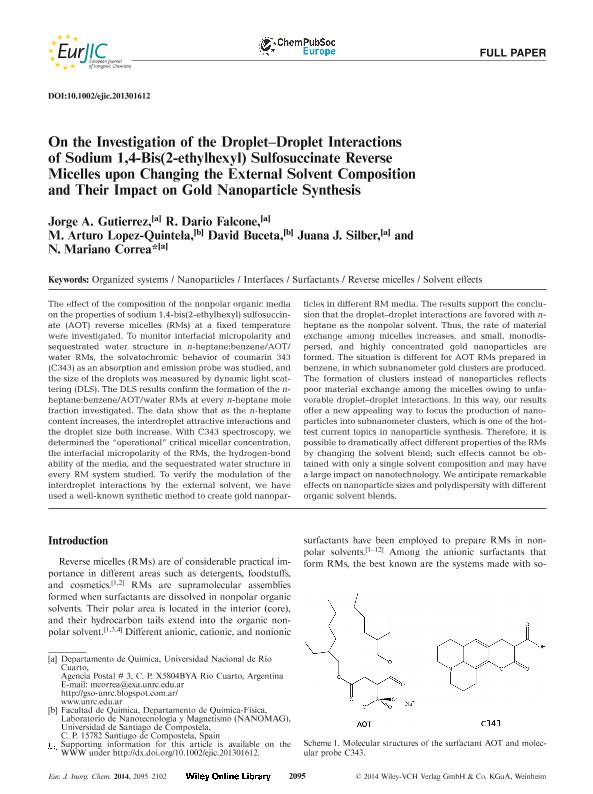Mostrar el registro sencillo del ítem
dc.contributor.author
Gutierrez Cifuentes, Jorge Andres

dc.contributor.author
Falcone, Ruben Dario

dc.contributor.author
Lopez Quintela, Arturo
dc.contributor.author
Buceta, David
dc.contributor.author
Chessa, Juana Josefa

dc.contributor.author
Correa, Nestor Mariano

dc.date.available
2018-01-18T19:42:02Z
dc.date.issued
2014-01
dc.identifier.citation
Gutierrez Cifuentes, Jorge Andres; Falcone, Ruben Dario; Lopez Quintela, Arturo; Buceta, David; Chessa, Juana Josefa; et al.; On the Investigation of the Droplet–Droplet Interactions of Sodium 1,4-Bis(2-ethylhexyl) Sulfosuccinate Reverse Micelles upon Changing the External Solvent Composition and Their Impact on Gold Nanoparticle Synthesis; Wiley VCH Verlag; European Journal of Inorganic Chemistry; 2014; 12; 1-2014; 2095-2102
dc.identifier.issn
1434-1948
dc.identifier.uri
http://hdl.handle.net/11336/33862
dc.description.abstract
The effect of the composition of the nonpolar organic mediaon the properties of sodium 1,4-bis(2-ethylhexyl) sulfosuccin-ate (AOT) reverse micelles (RMs) at a fixed temperaturewere investigated. To monitor interfacial micropolarity andsequestrated water structure inn-heptane:benzene/AOT/water RMs, the solvatochromic behavior of coumarin 343(C343) as an absorption and emission probe was studied, andthe size of the droplets was measured by dynamic light scat-tering (DLS). The DLS results confirm the formation of then-heptane:benzene/AOT/water RMs at everyn-heptane molefraction investigated. The data show that as then-heptanecontent increases, the interdroplet attractive interactions andthe droplet size both increase. With C343 spectroscopy, wedetermined the “operational” critical micellar concentration,the interfacial micropolarity of the RMs, the hydrogen-bondability of the media, and the sequestrated water structure inevery RM system studied. To verify the modulation of theinterdroplet interactions by the external solvent, we haveused a well-known synthetic method to create gold nanopar-IntroductionReverse micelles (RMs) are of considerable practical im-portance in different areas such as detergents, foodstuffs,and cosmetics.[1,2]RMs are supramolecular assembliesformed when surfactants are dissolved in nonpolar organicsolvents. Their polar area is located in the interior (core),and their hydrocarbon tails extend into the organic non-polar solvent.[1,3,4]Different anionic, cationic, and nonionic[a] Departamento de Química, Universidad Nacional de RíoCuarto,Agencia Postal # 3, C. P. X5804BYA Río Cuarto, ArgentinaE-mail: mcorrea@exa.unrc.edu.arhttp://gso-unrc.blogspot.com.ar/www.unrc.edu.ar[b] Facultad de Química, Departamento de Química-Física,Laboratorio de Nanotecnología y Magnetismo (NANOMAG),Universidad de Santiago de Compostela,C. P. 15782 Santiago de Compostela, SpainSupporting information for this article is available on theWWW under http://dx.doi.org/10.1002/ejic.201301612.Eur. J. Inorg. Chem.2014, 2095–2102© 2014 Wiley-VCH Verlag GmbH & Co. KGaA, Weinheim2095ticles in different RM media. The results support the conclu-sion that the droplet–droplet interactions are favored withn-heptane as the nonpolar solvent. Thus, the rate of materialexchange among micelles increases, and small, monodis-persed, and highly concentrated gold nanoparticles areformed. The situation is different for AOT RMs prepared inbenzene, in which subnanometer gold clusters are produced.The formation of clusters instead of nanoparticles reflectspoor material exchange among the micelles owing to unfa-vorable droplet–droplet interactions. In this way, our resultsoffer a new appealing way to focus the production of nano-particles into subnanometer clusters, which is one of the hot-test current topics in nanoparticle synthesis. Therefore, it ispossible to dramatically affect different properties of the RMsby changing the solvent blend; such effects cannot be ob-tained with only a single solvent composition and may havea large impact on nanotechnology. We anticipate remarkableeffects on nanoparticle sizes and polydispersity with differentorganic solvent blends.
dc.format
application/pdf
dc.language.iso
eng
dc.publisher
Wiley VCH Verlag

dc.rights
info:eu-repo/semantics/openAccess
dc.rights.uri
https://creativecommons.org/licenses/by-nc-sa/2.5/ar/
dc.subject
Organized Systems
dc.subject
Nanoparticles
dc.subject
Interfaces
dc.subject
Reverse Micelles
dc.subject
Surfactants
dc.subject
Solvent Effects
dc.subject.classification
Nano-materiales

dc.subject.classification
Nanotecnología

dc.subject.classification
INGENIERÍAS Y TECNOLOGÍAS

dc.title
On the Investigation of the Droplet–Droplet Interactions of Sodium 1,4-Bis(2-ethylhexyl) Sulfosuccinate Reverse Micelles upon Changing the External Solvent Composition and Their Impact on Gold Nanoparticle Synthesis
dc.type
info:eu-repo/semantics/article
dc.type
info:ar-repo/semantics/artículo
dc.type
info:eu-repo/semantics/publishedVersion
dc.date.updated
2018-01-17T15:03:46Z
dc.journal.volume
2014
dc.journal.number
12
dc.journal.pagination
2095-2102
dc.journal.pais
Alemania

dc.journal.ciudad
Weinheim
dc.description.fil
Fil: Gutierrez Cifuentes, Jorge Andres. Consejo Nacional de Investigaciones Científicas y Técnicas; Argentina. Universidad Nacional de Río Cuarto. Facultad de Ciencias Exactas Fisicoquímicas y Naturales. Departamento de Química; Argentina
dc.description.fil
Fil: Falcone, Ruben Dario. Consejo Nacional de Investigaciones Científicas y Técnicas; Argentina. Universidad Nacional de Río Cuarto. Facultad de Ciencias Exactas Fisicoquímicas y Naturales. Departamento de Química; Argentina
dc.description.fil
Fil: Lopez Quintela, Arturo. Universidad de Santiago de Compostela; España
dc.description.fil
Fil: Buceta, David. Universidad de Santiago de Compostela; España
dc.description.fil
Fil: Chessa, Juana Josefa. Consejo Nacional de Investigaciones Científicas y Técnicas; Argentina. Universidad Nacional de Río Cuarto. Facultad de Ciencias Exactas Fisicoquímicas y Naturales. Departamento de Química; Argentina
dc.description.fil
Fil: Correa, Nestor Mariano. Consejo Nacional de Investigaciones Científicas y Técnicas; Argentina. Universidad Nacional de Río Cuarto. Facultad de Ciencias Exactas Fisicoquímicas y Naturales. Departamento de Química; Argentina
dc.journal.title
European Journal of Inorganic Chemistry

dc.relation.alternativeid
info:eu-repo/semantics/altIdentifier/doi/http://dx.doi.org/10.1002/ejic.201301612
dc.relation.alternativeid
info:eu-repo/semantics/altIdentifier/url/http://onlinelibrary.wiley.com/doi/10.1002/ejic.201301612/abstract
Archivos asociados
